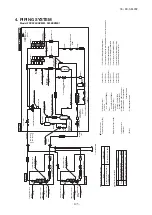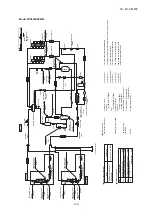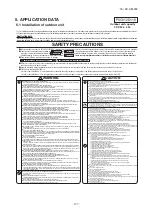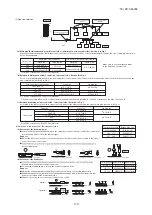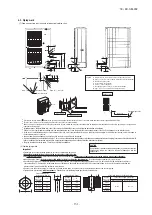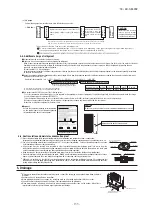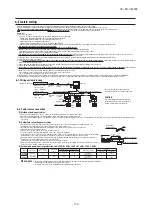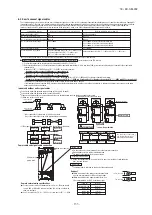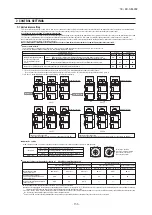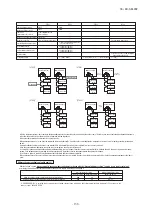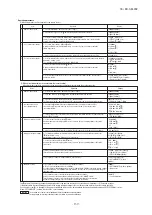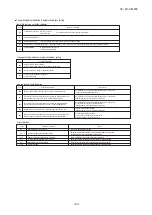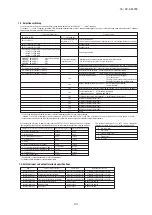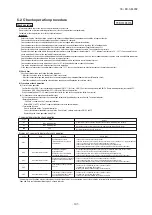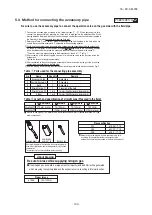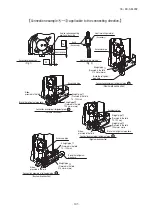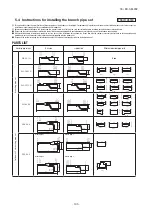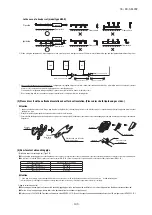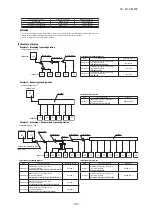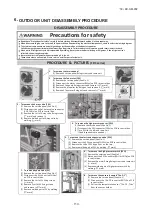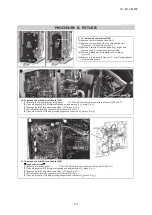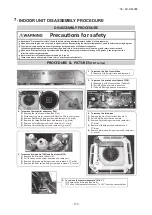
–
137
–
'18 • KX-SM-292
The communication protocol can be choosen from following two types. One of them is the conventional Superlink (hereinafter previous SL) and the other is the new Superlink
Ⅱ
(hereinafter new SL) . These two communication protocols have the following advantages and restrictions, so please choose a desirable one meeting your installation conditions
such as connected indoor units and central control. When signal cables are connected into a network involving outdoor units, indoor units or central control equipment
that do not support new SL, please select communications in the previous SL mode, even if the refrigerant system is separated from theirs.
(1) When one outdoor unit is used.
(1) The signal lines can also be connected using the method shown below.
○
Indoor and outdoor signal lines do not have a polarity.
Any of the connections in the following illustration can be made.
(2) When plural outdoor units are used
Outdoor unit
Outdoor unit
Signal line
Refrigerant pipe
Network connector
Outdoor unit
Indoor unit
Indoor unit
Indoor unit
Indoor unit
Indoor unit
Indoor unit
Outdoor unit
Outdoor unit
Indoor unit
Indoor unit
Indoor unit
Outdoor unit
Indoor unit
Indoor unit
Outdoor unit
Indoor unit
Indoor unit
Outdoor unit
Indoor unit
Outdoor unit
Indoor unit
Outdoor unit
Indoor unit
Outdoor signal line
terminal block
Indoor signal line
terminal block
○
Loop wiring prohibited.
The signal lines cannot form a
loop, so the wirings shown as .......
in the diagram are prohibited.
Important
●
Connect the signal line between indoor unit and outdoor unit to A1 and B1.
●
Connect the signal line between outdoor units to A2 and B2.
●
Please use a shielded cable for a signal line and connect a shielding earth at all the indoor units and outdoor units.
A
1 B1
A1・B1 A2・B2
A1
B1
A1
B1
A B
A B
A B
B
A
B
A
B
A
B
A
B
A
B
A
B
A
B
A
A1・B1 A2・B2
A1・B1 A2・B2
●
Address setting methods
The following address setting methods can be used. The procedure for automatic address setting is different from the conventional one.
Please use the automatic address setting function after reading this manual carefully.
This control system controls the controls of more than one air-conditioner's outdoor unit, indoor unit and remote control unit through communication control, using the microcomputers built in
the respective controls. Address setting needs to be done for both outdoor and indoor units. Turn on power in the order of the outdoor units and then the indoor units.
Use 1 minute as the rule of thumb for an interval between them.
The communication protocol can be chosen from following two types. One of them is the conventional communication protocol (previous SL) and the other is the new communication protocol (new
SL). These two communication protocols have their own features and restrictions as shown by Table 6-3. Select them according the indoor units and the central control to be connected.
When signal cables are connected into a network involving outdoor units, indoor units or central control equipment that do not support new SL, please select communications in the previous SL
mode, even if the refrigerant system is separated from theirs.
When communication is established after setting addresses, check the communication protocol with the 7-segment display panel of the outdoor unit.
Signal line
CASE 1
CASE 2
CASE 3
CASE 4
Refrigerant pipe
Network connector
Network connector
Network connector
Network connector
Outdoor unit
Outdoor unit
Outdoor unit
Indoor unit
Indoor unit
Indoor unit
Indoor unit
Indoor unit
Indoor unit
Outdoor unit
Outdoor unit
Outdoor unit
Indoor unit
Indoor unit
Indoor unit
Indoor unit
Indoor unit
Indoor unit
Outdoor unit
Outdoor unit
Outdoor unit
Indoor unit
Indoor unit
Indoor unit
Indoor unit
Indoor unit
Indoor unit
Outdoor unit
Outdoor unit
Outdoor unit
Indoor unit
Indoor unit
Indoor unit
Indoor unit
Indoor unit
Indoor unit
Indoor unit address setting
000
-
127[47]
000
000
00
-
31[47]
49
49
Indoor unit address setting
00
-
47
49
×
00
-
47
49
×
00
-
31[47]
49
00
-
31
Outdoor unit address setting
00
-
47
49
×
Outdoor unit address setting
0 1
2
3
4
5
6
7
8
9
0 1
2
3
4
5
6
7
8
9
●
Address No. setting
Set SW1 through 4 and SW5-2 provided on the PCB and SW1 & 2 provided on the outdoor unit PCB as shown in the drawings below.
※
1 Do not connect the signal line between outdoor units to A1 and B1. This may interrupt proper address setting. (Case 3)
Do not connect the signal line between indoor unit and outdoor unit to A2 and B2. This may interrupt proper address setting. (Case 4)
※
2 In Case 2, automatic address setting is not available. Set addresses manually.
A1・B1 A2・B2
B
A
B
A
B
A
B
A
B
A
B
A
A1・B1 A2・B2
A1・B1 A2・B2
A1・B1 A2・B2
B
A
B
A
B
A
B
A
B
A
B
A
A1・B1 A2・B2
A1・B1 A2・B2
A1・B1 A2・B2
B
A
B
A
B
A
B
A
B
A
B
A
A1・B1 A2・B2
A1・B1 A2・B2
A1・B1 A2・B2
B
A
B
A
B
A
B
A
B
A
B
A
A1・B1 A2・B2
A1・B1 A2・B2
×
×
●
Summary of address setting methods (figures in [ ] should be used with previous SL)
Do not set numbers other than those shown in the table, or an error may be generated.
Note: When units supporting new SL are added to a network using previous SL such as one involving FD
○
A
△△
KXE4 series units, choose previous SL for the communication protocol and set addresses manually.
Since the models FDT224 and 280 have 2 PCBs per unit, set different indoor unit No. and SW on each PCB.
●
An outdoor unit No., which is used to identify which outdoor unit and indoor units are connected in a refrigerant system, is set on outdoor unit PCB and indoor unit PCB. Give the same outdoor unit
No. to all outdoor unit and indoor units connected in same refrigerant system.
●
An indoor unit No. is used to identify individual indoor units. Assign a unique number that is not assigned to any other indoor units on the network.
Incorrect cable connection
(The signal line between outdoor units is connected to A1 and B1)
Incorrect cable connection
(The signal line between indoor unit and outdoor units is connected to A2 and B2)
Manual address setting
(previous SL/new SL)
Units supporting new SL
Units NOT supporting new SL
SW1 (SW3)
SW2 (SW4)
For ten’s place
For one’s place
By inserting a flat driver
(precision screwdriver) into this
groove and turn the arrow to
point a desired number.
Indoor PCB
Outdoor PCB
SW1, 2 (blue)
SW3, 4 (green)
SW5-2
SW1, 2 (green)
For setting indoor No. (The ten’s and one’s)
For setting outdoor No. (The ten’s and one’s)
Indoor No. switch (The hundred’s Place) [OFF : 0, ON : 1]
For setting outdoor No. (The ten’s and one’s)
Automatic address setting for
multiple refrigerant systems installation
(with new SL only)
Automatic address setting for
single refrigerant system installation
(previous SL/new SL)
Indoor No. switch
Outdoor No. switch
Outdoor No. switch
Indoor No. switch
Outdoor No. switch
Outdoor No. switch
(1) In the case of a single refrigerant system installation
(Generally applicable to new SL/previous SL, use figures in [ ] with previous SL.)
①
Outdoor unit address setting
Set as follows before you turn on power.
Make sure that the
Outdoor Unit No. switch
is set to
49 (factory setting)
②
Indoor unit address setting
Set as follows before you turn on power.
Make sure that the
Indoor Unit No. switch
is set to
000 [in the case of previous SL: 49] (factory setting)
Make sure that the
Outdoor Unit No. switch
is set to
49 (factory setting)
③
Turn on power in order from the outdoor unit to indoor units. Give a one-minute or longer interval for them. Unlike the procedure set out in (2) below, you need not change settings from the 7-
segment display panel.
④
Make sure that the number of indoor units indicated on the 7-segment display panel agrees with the number of the indoor units that are actually connected to the refrigerant system.
(2) In the case of a multiple refrigerant systems installation
(Applicable to new SL only. In the case of previous SL, set addresses with some other method.)
(This option is available when the interconnection wiring among refrigerant systems is on the outdoor side and new SL is chosen as the communication protocol.)
Address setting procedure
(perform these steps for each outdoor unit)
[STEP1]
(Items set before turning on power)
①
Outdoor unit address setting
Set as follows before you turn on power.
Set the
Outdoor Unit No. switch
to a number
00 - 31
. Set a unique number by avoiding the numbers assigned to other outdoor units on the network.
②
Indoor unit address setting
Set as follows before you turn on power.
Make sure that the
Indoor Unit No. switch
is set to
000 (factory setting)
Make sure that the
Outdoor Unit No. switch
is set to
49 (factory setting)
③
Isolate the present refrigerant system from the network.
Disengage the
network connectors (white 2P)
of the outdoor units. (Turning on power without isolating each refrigerant system will result in erroneous address setting.)
[STEP2]
(Power on and automatic address setting)
④
Turn on power to the outdoor unit
Turn on power in order from the outdoor unit to indoor units. Give a one-minute or longer interval for them.
⑤
Select and enter “1” in P31 on the 7-segment display panel of each outdoor unit to input “Automatic address start.”
⑥
Input a starting address and the number of connected indoor units.
Input a starting address in P32 on the 7-segment display panel of each outdoor unit.
⑦
When a starting address is entered, the display indication will switch back to the “Number of Connected Indoor Units Input” screen.
Input the number of connected indoor units from the 7-segment display panel of each outdoor unit. Please input the number of connected indoor units for each outdoor unit. (You can input it
from P33 on the 7-segment display panel.) When the number of connected indoor units is entered, the 7-segment display panel indication will switch to “AUX” and start flickering.
[STEP3]
(Automatic address setting completion check)
⑧
Indoor unit address determination
When the indoor unit addresses are all set, the 7-segment display panel indication will switch to “AUE” and start flickering.
If an error is detected in this process, the display will show “A
○○
.”
Check the 7-segment display panel of each outdoor unit.
Depending on the number of connected indoor units, it may take
about 10 minutes
before the indoor unit addresses are all set.
[STEP4]
(Network definition setting)
⑨
Network connection
When you have confirmed an “AUE” indication on the display of each outdoor unit,
engage the network connectors
again.
⑩
Network polarity setting
After you have made sure that the network connectors are engaged
in
⑧
, select and enter “1” in P34 on the 7-segment display panel of
any outdoor unit (on only 1 unit)
to specify
network polarity.
⑪
Network setting completion check
When the network is defined, “End” will appear on the 7-segment display panel. An “End” indication will go off, when some operation is made from the 7-segment display panel or
3 minutes after.
①
Outdoor unit address setting
Set as follows before you turn on power. Upon turning on power, the outdoor unit address is registered.
Set
the Outdoor Unit No. switch to a number 00 - 31 [in the case of previous SL: 00 - 47]
.
Set a unique number by avoiding the numbers assigned to other outdoor units on the network.
②
Indoor unit address setting
Set as follows before you turn on power. Upon turning on power, the indoor unit address is registered.
Set
the Indoor Unit No. switch to a number 000 - 127 [in the case of previous SL: 00 - 47]
.
Set
the Outdoor Unit No. switch
to the outdoor unit No. of the associated outdoor unit within the range of
00 - 31 [in the case of previous SL: 00 - 47].
Set a unique number by avoiding the numbers assigned to other indoor units on the network.
③
Turn on power in order from the outdoor unit to indoor units. Give a one-minute or longer interval for them.
* When there are some units not supporting new SL connected in the network, set SW5-5 to ON to choose the previous SL communication mode.
In the case of previous SL, the maximum number of indoor units connectable in a network is 48.
Automatic address setting Generally applicable to new SL/previous SL, use figures in [ ] with previous SL.
Unless stated otherwise, the following procedures apply, when new SL is chosen for the communication protocol.
When previous SL is chosen, use figures shown in [ ] in carrying out these procedures.
Manual address setting Generally applicable to new SL/previous SL, use figures in [ ] with previous SL.
With new SL, you can set indoor unit addresses automatically even for an installation involving multiple refrigerant systems connected with same network, in addition to the conventional automatic
address setting of a single refrigerant system installation.
However, an installation must satisfy some additional requirements such as for wiring methods, so please read this manual carefully before you carry out automatic address setting.
Signal line
Refrigerant pipe
Outdoor unit [01]
Outdoor unit [02]
Indoor unit
Indoor unit
Indoor unit
Indoor unit
Indoor unit
Indoor unit
Address change (available only with new SL)
・
Within a refrigerant system, indoor units are assigned addresses in the order they are recognized by the outdoor unit. Therefore, they are not necessarily assigned addresses in
order from the nearest to the outdoor unit first as depicted in drawings above.
・
Make sure that power has been turned on to all indoor units.
・
When addresses are set, you can have the registered indoor unit address No.’s and the outdoor unit address No. displayed on the remote control unit by pressing its Inspection
switch.
・
Automatic address setting can be used for an installation in which prulal indoor units are controlled from one remote control unit.
・
Once they are registered, addresses are stored in microcomputers, even if power is turned off.
・
If you want to change an address after automatic address setting, you can change it from the remote control unit with its “Address Change” function or by means of manual
setting. Set a unique address by avoiding the address assigned to other indoor unit on the network when the address is changed.
・
Do not turn on power to central control equipment until automatic address setting is completed.
・
When addresses are set, be sure to perform a test run and ensure that you can operate all indoor and outdoor units normally. Also check the addresses assigned to the indoor
units.
②
OFF
①
OFF
②
indoor000/outdoor 49
(
factory setting
)
①
01,02(Ex
)
③
Disconnect(each outdoor unit)
STEP1
STEP2
STEP3
STEP4
Indoor unit
(
00
)
+01
Indoor unit
(
01
)
+01
Indoor unit
(
02
)
+01
Indoor unit
(
00
)
+04
Indoor unit
(
01
)
+04
Indoor unit
(
02
)
+04
Indoor unit
01
Indoor unit
02
Indoor unit
03
Indoor unit
02
Indoor unit
03
Indoor unit
04
Indoor unit
05
Indoor unit
06
Indoor unit
04
Indoor unit
05
Indoor unit
06
[
STEP1
]
[
STEP2
]
[
STEP3
]
[
STEP4
]
Outdoor unit [01]
Start [01]
Number [03]
Start [04]
Number [03]
Outdoor unit [02]
Outdoor unit [01]
Outdoor unit [02]
Outdoor unit [01]
Outdoor unit [02]
ー
ー
ー
ー
⑨
Connect(each outdoor unit)
ー
ー
⑩
Set in P34 on the 7-segment display
panel of any outdoor unit.
⑪「
End
」
ー
ー
ー
ー
ー
ー
ー
ー
⑧
“AUE”(blink), or “A
○○
” in error events.
Indoor unit power source
Outdoor unit power source
Indoor unit
(indoor/outdoor No.switch)
Outdoor unit (outdoor No.switch)
Network connectors
Start automatic address setting
Set starting address
Set the number of indoor unit
Polarity setting
7-segment display
Indoor unit
01
Indoor No.switch
000
000
Outdoor No.switch
49
49
Indoor unit address setting
Outdoor unit address setting
Outdoor No.switch
49
00
-
31
“Address Change” is used,
when you want to change an indoor unit address assigned with the “Automatic Address Setting” function from a remote control unit
.
Accordingly, the conditions that permit an address change from a remote control unit are as follows.
If “CHANGE ADD.
▼
” is selected with some addresses falling outside these conditions, the following indication will appear for 3 seconds on the
remote control ”INVALID OPER” .
Automatic address setting for multiple refrigerant systems installation
Automatic address setting forsingle refrigerant system installation
④
ON
④
ON
Polarity
setting
⑦
outdoor 01:
「
03
」
(Ex)
outdoor 02:
「
03
」
(Ex)
⑥
outdoor 01:
「
01
」
(Ex)
outdoor 02:
「
04
」
(Ex)
⑤
Select “Automatic Address Start”
on each outdoor unit.
⑦[
AUX
]
(Blink
)
ー
ー
ー
ー
●
Signal cables are for DC 5 V. Never connect wires for 220/240 V or 380/415 V.
Protective fuse on the PCB will trip.
①
Confirm that signal cables are prevented from applying 220/240 V or 380/415 V
②
Before turning the power on, check the resistance on the signal cable terminal block. If it is less than 100Ω, power source cables may be connected to the signal cable
terminal block.
When units of FD
○△△
KXE6 Series, FD
○△△
KXZE1 series are connected:
Standard resistance value=5,100/Number of connected units.
When units of FD
○
A
△△
KXE4 and 5 Series only are connected:
Standard resistance value=9,200/Number of connected units.
When units of FD
○△△
KXE6 Series, FD
○△△
KXZE1 series and units of FD
○
A
△△
KXE4 and 5 Series are connected in a mixture:
Standard resistance value=46,000/[(Number of connected FD
○
A
△△
KXE4 and 5 Series units x 5) + (Number of connected FD
○△△
KXE6 and KXZ Series units x 9)]
The number of connected units includes those of indoor units, outdoor units and SL devices..
If the resistance value is less than 100Ω, disconnect the signal cables temporarily to divide to more than one network, to reduce the number of indoor units on the same
network, and check each network.
Outdoor unit setting (SW5-5)
No. of connectable indoor units
No. of connectable outdoor units in a network
No. of connectable outdoor units
Signal cable (furthest length)
Connectable units to a network
ON
Max. 48
Max. 48
Up to 1000m
Up to 1000m
Units not supporting new SL (FD
○
A
△△
KXE4.5 series)
Units supporting new SL (FD
○△△
KXE6 series,
FD
○△△
KXZ series) Can be used together.
OFF (Factory default)
Max. 128
Max. 32
Up to 2,000 m for wires other than shielding wire
Up to 1,500 m for 0.75 mm
2
shielding wire (MVVS)
Up to 1,000 m for 1.25 mm
2
shielding wire (MVVS)
Up to 1000m
Units supporting new SL (FD
○△△
KXE6 series, FD
○△△
KXZ series)
Conventional communication protocol (previous SL)
Communication protocol
New communication protocol (new SL)
Note: For FDT224 and 280 models, calculate the number of units taking 1 indoor unit as 2 units for the sake of communication.
Network connector
Earth wire is
giving slack.
Wiring label
●
The wiring label is attached on the back of the service panel.
Outgoing cable direction
●
Fix the cables not to exert external force to the terminal connection.
●
As like the refrigerant pipe, it can be let out in any of 4 directions of right-hand side,
front, rear and bottom.
●
Give adequate slack to cables in fastening them.
●
Fix power cables separately from signal cables.
Wiring clamp
12.5 mm or less
7 mm or less
Length (m)
Within 100 - 200
Within - 300
Within - 400
Within - 600
Wire size
0.5
mm
2
0.75
mm
2
1.25
mm
2
2.0
mm
2
7-1. Unit address setting
Communication protocol
Address setting method
OK
※
1
×
※
2
OK
OK
OK
OK
OK
OK
OK
×
×
OK
new SL
previous SL
Automatic Manual Automatic Manual
7. CONTROL SETTINGS
Case 1
Case 2
When signal lines linking plural refrigerant systems are provided between outdoor units.
(When the network connector is disconnected, refrigerant systems are separated each other)
When signal lines linking plural refrigerant systems are provided between indoor units.
When only one refrigerant system is involved (signal lines do not link plural refrigerant systems)
Indoor and outdoor units signal cables
Power cable and signal cable connection
Request
●
When connecting to the power source terminal block,
use the crimp terminals for M5 as shown at right.
●
When connecting to the signal terminal block, use
the crimp terminals for M3.5 as shown at right.
Remote control wiring specifications
●
For the remote control the standard wire is 0.3 mm
2
. The max. length
is up to 600 m. When the wire is more than 100 m long, use the wire
shown in the table.
●
Use 3-core wires for
FD
○
A
△△
KXE4
or 2-core wires for
FD
○△△
KXE6
.
When plural refrigerant systems
are linked with signal lines
(e.g., to implement central
control)
6-3. How to connect signal cables
Summary of Contents for FDC224KXZME1
Page 169: ... 168 18 KX SM 292 PHA012D402 ...
Page 170: ... 169 18 KX SM 292 Screw ...
Page 171: ... 170 18 KX SM 292 ...
Page 172: ... 171 18 KX SM 292 ...



